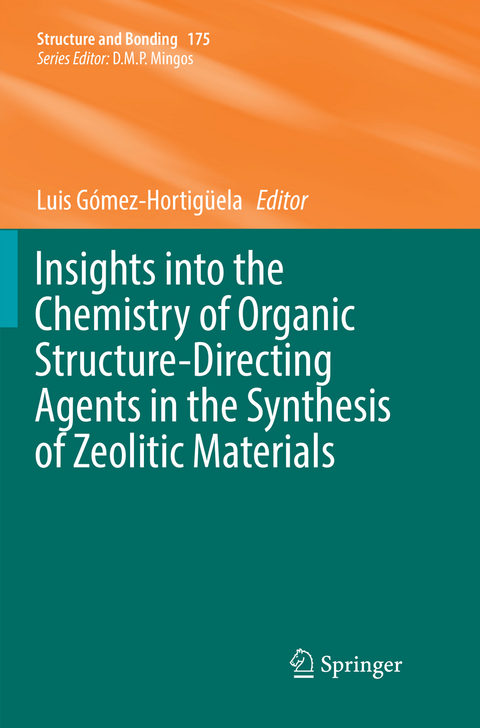
Insights into the Chemistry of Organic Structure-Directing Agents in the Synthesis of Zeolitic Materials
Springer International Publishing (Verlag)
978-3-030-08955-9 (ISBN)
This edited volume focuses on the host-guest chemistry of organic molecules and inorganic systems during synthesis (structure-direction). Organic molecules have been used for many years in the synthesis of zeolitic nanoporous frameworks. The addition of these organic molecules to the zeolite synthesis mixtures provokes a particular ordering of the inorganic units around them that directs the crystallization pathway towards a particular framework type; hence they are called structure-directing agents. Their use has allowed the discovery of an extremely large number of new zeolite frameworks and compositions.
This volume covers the main aspects of the use of organic molecules as structure-directing agents for the synthesis of zeolites, including first an introduction of the main concepts, then two chapters covering state-of-the-art techniques currently used to understand the structure-directing phenomenon (location of molecules by XRD and molecular modeling techniques). The most recent trends in the types of organic molecules used as structure-directing agents are also presented, including the use of metal-complexes, the use of non-ammonium-based molecules (mainly phosphorus-based compounds) and the role of supramolecular chemistry in designing new large organic structure-directing agents produced by self-aggregation. In addition the volume explores the latest research attempting to transfer the asymmetric nature of organic chiral molecules used as structure-directing agents to the zeolite lattice to produce chiral enantioselective frameworks, one of the biggest challenges today in materials chemistry.
This volume has interdisciplinary appeal and will engage scholars from the zeolite community with a general interest in microporous materials, which involves not only zeolite scientists, but also researchers working on metal-organic framework materials. The concepts covered will also be of interest for researchers working on the application of materials after encapsulation of molecules of interest in post-synthetic treatments. Further the work explores the main aspects of host-guest chemistry in hybrid organo-inorganic templated materials, which covers all types of materials where organic molecules are used as templates and are confined within framework-structured inorganic materials (intercalation compounds). Therefore the volume is also relevant to the wider materials chemistry community.
Luis Gómez-Hortigüela is a researcher at the Instituto de Catálisis y Petroleoquímica-CSIC. His research focuses on the development of advanced zeolitic nanoporous materials with improved catalytic properties through the use of rationally-designed organic molecules as structure-directing agents. This research combines the use of molecular-mechanics and quantum mechanics simulation techniques with the actual synthesis and advanced characterization of zeolitic materials in an attempt to reach a molecular-level knowledge of the phenomena taking place during the structure-direction of these materials. Specific research focuses on the use of self-assembling aromatic amines/ammonium compounds as organic structure-directing agents in order to produce large-pore nanoporous materials by applying concepts of supramolecular chemistry. Moreover, the use of self-assembling chiral compounds as structure-directing agents in an attempt to induce a chiral supramolecular ordering that could be transferred into a potential chiral zeolite framework, thus leading to enantioselective adsorbents and/or catalysts. In addition, Dr Gómez-Hortigüela's research also looks at attempting to control the location of active sites in zeolite frameworks by the rational use of specific structure-directing agents. Research is also carried out to take advantage of the peculiar ion-exchanging properties of zeolite materials for controlling the growth of inorganic nanoparticles on zeolite surfaces for water-treatment applications.
Introduction of structure-directing phenomenon by organic molecules: general aspects.- Location of organic structure-directing agents by diffraction techniques.- Molecular modelling of organic structure-direction phenomena.- Beyond nitrogen organic structure-directing agents.- Role of supramolecular chemistry during templating phenomenon in zeolite synthesis.- Metal Complexes as structure directing agents for zeolites and related microporous materials.- Chiral organic structure-directing agents.
| Erscheinungsdatum | 05.03.2022 |
|---|---|
| Reihe/Serie | Structure and Bonding |
| Zusatzinfo | VII, 250 p. |
| Verlagsort | Cham |
| Sprache | englisch |
| Maße | 155 x 235 mm |
| Gewicht | 403 g |
| Themenwelt | Naturwissenschaften ► Chemie ► Physikalische Chemie |
| Schlagworte | Chiral organic structure • organic molecules • Organic Structure-Directing Agents • Zeolite frameworks • Zeolite synthesis |
| ISBN-10 | 3-030-08955-X / 303008955X |
| ISBN-13 | 978-3-030-08955-9 / 9783030089559 |
| Zustand | Neuware |
| Haben Sie eine Frage zum Produkt? |
aus dem Bereich


